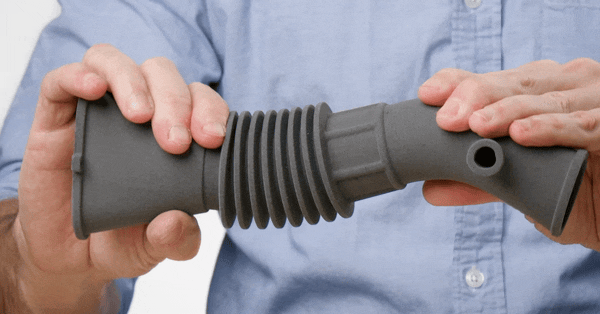Formlabs® has introduced Silicone 40A resin, the first accessible pure silicone 3D printing material. Thanks to their patent-pending Pure Silicone Technology™, you can now 3D print silicone parts with outstanding material properties.
Direct Silicone 3D Printing
Produce 100% silicone parts in-house with Formlabs Silicone 40A resin and the Formlabs 3D printing ecosystem.
3D Printing with silicone-like materials
Manufacturers often opt for silicones due to their elasticity and flexibility, which enable diverse applications.
Silicones typically exhibit a Shore durometer hardness ranging from 10A to 80A. Conventional polymer 3D printing methods like fused deposition modeling (FDM), stereolithography (SLA), and selective laser sintering (SLS) provide materials within this hardness range, offering varying degrees of similarity in essential material properties compared to silicone. These properties include durability, thermal stability, UV resistance, food safety, biocompatibility, and options for colour and translucency.
![]()
PROS
- For FDM 3D printing, elastomers such as thermoplastic polyurethane (TPU) and thermoplastic elastomer (TPE) are the most flexible materials that offer an alternative to silicone. These materials are commercially available at Shore 45A to Shore 90A hardness, which covers the harder end of the silicone hardness range.
CONS
- The pros associated with these alternatives are the general affordability of FDM 3D printers and materials. Conversely, the cons include lower precision and dimensional accuracy, low resolution, quality, and part strength, and limited design freedom that restricts real-world usability. Silicone-like FDM materials are generally less durable than standard silicone, not food-safe, have lower temperature resistance, and offer limited colour and no real translucency options, but they can be biocompatible and skin-safe.
PROS
- SLA 3D printing offers multiple alternatives to silicone that empower manufacturers to prototype silicone-like parts or even manufacture end-use parts with silicone’s flexibility, elasticity, and durability. SLA parts offer the smoothest surface finish and greater design freedom than FDM.
CONS
- Silicone-like flexible 3D printing resins are generally less durable than standard silicone, not food-safe, not biocompatible (but can be skin-safe), and have lower temperature resistance. Silicone-like SLA materials can be translucent and dyed to different colours
Alternative materials to silicone among Formlabs’ SLA 3D printing materials include:
.
PROS
- SLS materials with silicone-like properties include TPU, TPE, and TPA, offering hardness ranges between 45A and 90A Shore. The exact availability is dependent on the printer model.
- SLS 3D printing technology gives you freedom of design. Plus, there are no support structures being printed, thus less used material.
- Parts produced with silicone-like SLS materials are accurate, durable, and wear-resistant. They have the highest temperature resistance of the three plastic 3D printing processes and can be biocompatible, skin-safe, and also food-safe after post-processing.
CONS
- SLS printing offers limited colour and no translucency options, and designs with thin walls may warp while cooling down.

Casting or molding silicone using 3D-printed molds
Molding methods like injection molding, thermoforming, compression molding, and silicone casting rely on molds to shape silicone products. But getting these molds can be pricey and time-consuming, delaying product development and market release.
By bringing rapid tooling in-house, businesses can test designs and materials quickly and affordably before mass production. This speeds up the process and allows for custom or limited production runs.